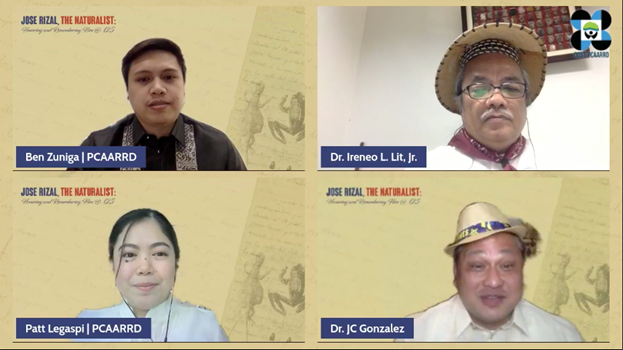Dr. Jose P. Rizal, a hero and an inspiration to modern scientists - DOST experts

Dr. Jose P. Rizal’s numerous accomplishments in his life revolved around his passion for the natural sciences. He refused to be limited by fascination over the beauty of nature alone. He took his love for living things to greater heights and paved the way for exploration, discovery, and introduction of species found in the Philippines to the world.
“Ang Pilipinas ay itinuturing na isa sa megadiverse na bansa sa buong mundo dahil matatagpuan sa atin ang napakaraming globally important species na mga halaman, hayop, at microorganisms,” Department of Science and Technology (DOST) Undersecretary Rowena Cristina L. Guevara said during the Jose Rizal, The Naturalist: Honoring and Remembering Him @ 125 webinar, organized by the DOST- Philippine Council for Agriculture, Aquatic and Natural Resources Research and Development (PCAARRD).
“Ang kanyang adhikain na pangalagaan at konserbahin ang iba’t ibang uri ng species ng insect, halaman, at hayop ay inspirasyon at pundasyon para sa mga mananaliksik sa panahon ngayon. Masasabi rin natin na si Dr. Jose Rizal ay isang dakilang mananaliksik
at siyentista na maaaring gawing ehemplo ng mga kabataan at kawani ng gobyerno,” Guevara added.
On the other hand, DOST Secretary Fortunato T. de la Peña said that Dr. Rizal’s significant contributions to the advancement of science and technology in the country inspired numerous individuals and groups to follow in his footsteps and make their own mark in the scientific community.
“Dahil dito ay may mga bagong tuklas na saribuhay ang isinunod sa kanyang pangalan bilang pagkilala sa kanyang mga kontribusyon at kabayanihan,” de la Peña said.
“Hindi maitatatwa na ang kahusayan na ipinamalas ni Dr. Rizal ay mababanaag natin sa mga nagdaan at kasalukuyang siyentistang Pilipino. Ang kanyang galing at pagmamahal sa bayan ay sumasalamin sa ating mga siyentistang patuloy na tumutuklas ng mga bagong kaalaman para sa ikauunlad ng buhay ng kanilang kapwa Pilipino. Patunay ito ng makabagong uri ng kabayanihan, ang paglilingkod sa bayan,” Secretary de la Peña added.
The webinar held on 31 January 2022 invited two experts from the University of the Philippines Los Baños - Museum of Natural History (UPLB-MNH): Dr. Juan Carlos T. Gonzales, curator of birds and Dr. Ireneo L. Lit Jr., curator of mealybugs and scale insects.
Both experts discussed Dr. Rizal’s penchant for our natural environment which began in his early childhood. Having been born in Calamba, Laguna, Rizal was captivated by the beauty of Mount Makiling and Laguna de Bay. His family’s home also has a garden where he spent time looking at birds including sunbirds and flowerpeckers. Moreover, our national hero’s interest in plants, animals, and science in general developed over the years, led him to pursue studies in Mineralogy, Botany, and Zoology, among others.
Dr. Rizal was also successful in fusing the sciences with the arts. Plants and animals were a common theme in his sketches, illustrations, and even sculptures such as the Mother’s Revenge - which shows a mother dog trying to rescue her helpless pup from the bite of a crocodile. Dr. Rizal made the clay sculpture during his exile in Dapitan.
When he was in Dapitan, Dr. Rizal also explored the area’s wilderness. He went on to sketch and collect samples of plants, reptiles, birds, insects, bugs, crustaceans, and seashells that he found. He collaborated with foremost scientists from Europe to study these specimens. One of them is Adolf B. Meyer of Dresden Museum in Germany, an ornithologist, entomologist, and herpetologist.
Some of these animal specimens were named after Dr. Rizal. They were Rhacophorus rizali, a rare kind of frog; Draco rizali, also known as flying lizard, a new species of its kind; and Apogonia Rizali, a peculiar type of beetle.
“Just like Jose Rizal, you can be a naturalist. Maganda kung mag-aaral kayo ng biology, zoology, entomology and be a taxonomist kasi kailangang-kailangan natin ‘yan,” Dr. Gonzales urged the youth.
He also underscored the importance of maintaining specimen collections because of their potential as instruments for advanced studies.
“[Dr. Jose Rizal] was able to collect specimens that may be used to study climate change. Specimens are historical accounts. You can get isotopes from shells and determine ano impact ng changes in oxygen levels or carbon dioxide levels. Maraming pwedeng aralin. These specimens are important. Sadly, a lot of them are lost but still, a lot of them are there. ‘Yun ang importante: to keep heritage collections alive, not just Jose Rizal’s collections but all heritage collections,” Dr. Gonzales added.
Meanwhile, Dr. Lit emphasized that we should learn from our heroes who fought hard to make our society better for all especially the poorest and most vulnerable. Like DOST Secretary de la Peña and DOST Undersecretary Guevara, Dr. Lit believes that scientists in the past were and up to the present are deeply inspired by our heroes, including Dr. Rizal.
He mentioned that, in fact, there are arthropods named after other Filipino revolutionaries. They were Hogna bonifacioi (spider), Phyllium bonifacioi (leaf insect), and Pharnacia magdiwang (stick insect) after Andres Bonifcaio; Venonia gabrielae (spider) after Gabriela Silang; Pardosa mabinii (spider) and Tripteroides mabinii (mosquito) after Apolinario Mabini; and Erigone malvari (black dwarf spider) after General Miguel Malvar.
At the end of his presentation, Dr. Lit challenged today’s men and women of science to “find their way forward” - to liberate the people toward scientific literacy, promote knowledge of entomological and other biodiversity resources, and empower the youth with what science and scientific endeavors can deliver for them and the country. (By Jil Danielle M. Caro, DOST-STII,)

